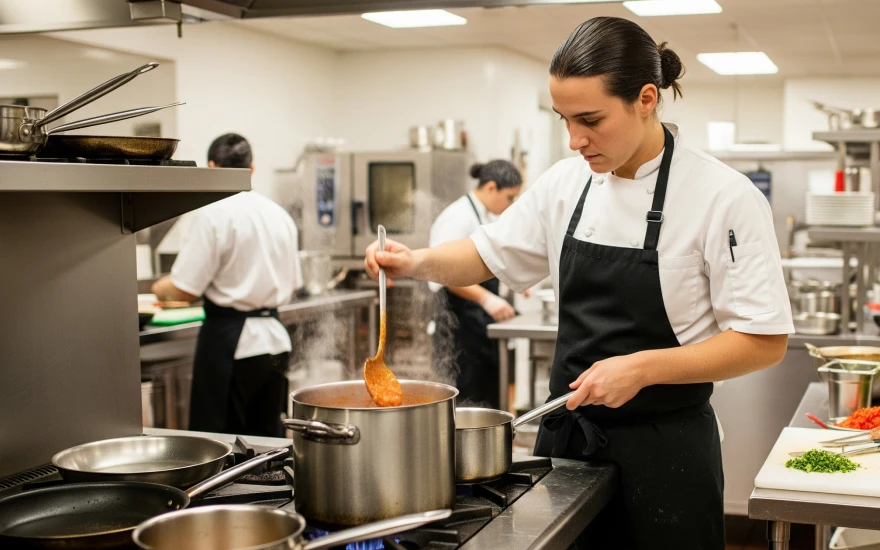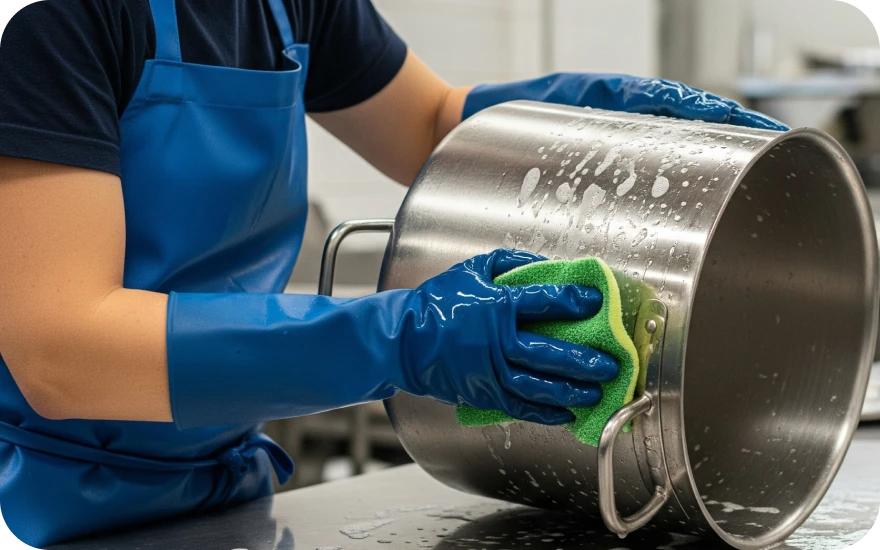How to Take Care of Stainless Steel Cookware in Commercial Kitchens

Stainless steel cookware is essential in commercial kitchens, but it can quickly lose its shine. With heavy use, it’s prone to staining, scratching, and tarnishing, especially if it’s not properly maintained. Over time, this can affect its performance and appearance, leaving your cookware looking worn out. If you're not careful, the cookware could also lose its non-reactive surface, which is one of its key benefits.
But there's good news. With the right care, stainless steel cookware can last for years. Simple yet effective techniques can help maintain its durability and pristine condition. In this article, you'll discover the essential steps to preserve your cookware, keeping it looking new and performing at its best in the high-pressure environment of a commercial kitchen.
By following these guidelines, you can avoid common mistakes that lead to damage. You’ll learn how to clean, store, and maintain your cookware so it remains a reliable tool in your kitchen. Keep reading to unlock the secrets to making your stainless steel cookware last longer.
What is Stainless Steel Cookware?
Stainless steel cookware is made from a combination of iron, carbon, and chromium. The chromium content gives it its rust-resistant and durable properties. There are several grades of stainless steel used in cookware, but the most common are 18/10 and 18/8. These numbers refer to the percentage of chromium and nickel content, making the cookware strong and resistant to corrosion. If you're looking to outfit your kitchen with high-quality, long-lasting tools, you may consider purchasing stainless steel cookware sets that provide consistent performance across various cooking tasks.
Commercial kitchens prefer stainless steel due to its durability, heat conductivity, and non-reactive surface. It can withstand high temperatures without warping, which is crucial in busy kitchen environments. Stainless steel doesn't react with acidic foods, preserving the taste and quality of the food being prepared.
However, in high-demand kitchens, stainless steel cookware faces some challenges. Stains, scratches, and tarnishing are common issues. Daily exposure to grease, acids, and harsh cleaning can cause wear and tear, affecting both its appearance and performance.

Proper Cleaning Techniques for Stainless Steel Cookware
To preserve the appearance and function of your stainless steel cookware, always use the right cleaning tools. Avoid abrasive scrubbers that can scratch the surface. Instead, opt for non-scratch cleaning pads to keep the cookware smooth and free from marks.
Hand washing is often the best option for stainless steel. While dishwashers may be convenient, they can cause the cookware to degrade faster. Manual cleaning ensures you can address problem areas immediately and avoid potential damage from dishwasher detergents and high heat.
After each use, clean the cookware promptly to prevent food residue from sticking. For greasy pans, use warm water and a gentle dish soap. For burnt cookware, soak it in a mixture of baking soda and water, then scrub gently with a non-abrasive pad or steel wool. This will lift stubborn food particles without harming the surface.
Using non-toxic cleaners is also recommended. They’re effective at cleaning without damaging the steel, ensuring safe and long-lasting cookware. Avoid abrasive cleaners as they can scratch the surface, degrade the finish, and compromise the cookware’s resistance to rust and staining over time.
Preventing Stains and Discoloration
Stains and discoloration on stainless steel pans and pots are usually caused by food acids, heat exposure, and mineral deposits. Tomato-based sauces, vinegar, and citrus can leave behind stubborn stains. High heat can cause discoloration, while minerals in water may lead to water spots.
As part of restaurant management, cleaning cookware immediately after use is key to preventing permanent staining. When you leave food residue on the cookware, it can react with the surface, causing stains that are difficult to remove. Prompt cleaning helps to avoid these issues, keeping your cookware looking new.
If tarnishing or discoloration occurs, restoring the shine is simple. Use a mixture of baking soda and water or a stainless steel cleaner to remove the buildup. Gently scrub with a soft scouring pad or cloth to bring back the cookware’s gleam.
Regular polishing helps maintain a bright finish. Apply a stainless steel polish after cleaning to keep your cookware gleaming and protected from future stains and discoloration.

Safeguarding Against Scratches and Dents
Proper storage is crucial to preventing scratches and dents. When storing cookware, avoid stacking them directly on top of each other. Use protective liners or soft cloths between pans to reduce friction. This simple step will help maintain their appearance and prevent damage over time.
Another key practice is avoiding metal utensils. Sharp-edged metal tools can scratch the surface of your cookware, leaving permanent marks. Instead, use utensils made from silicone, wood, or plastic. These materials are gentle on the cookware and prevent unnecessary wear.
When handling stainless steel pans, be mindful of how you lift, move, and transfer them. Always lift cookware by the handles to avoid placing pressure on the body. Avoid dropping or dragging the cookware, as this can lead to dents. Handle with care to ensure it remains in top condition.
Dealing With Heavy Use: Maintenance Tips for Commercial Kitchens
In commercial kitchens, periodic deep cleanings are essential for maintaining cookware. While regular cleaning keeps the cookware in good condition, deep cleanings remove stubborn grime and prevent buildup that could lead to long-term damage. Schedule deep cleans every few months to ensure the cookware stays in top shape.
Watch for signs of wear and tear, such as cracks, warping, or persistent stains that can’t be removed. When cookware shows these signs, it’s time to consider repairs or replacement. Continuing to use damaged cookware can compromise safety and performance in the kitchen.
To maximize the longevity of your stainless steel cookware, invest in regular care. Proper cleaning, storage, and handling will help your cookware last longer without the need for costly replacements. By following these simple steps, you’ll ensure your cookware stands the test of time and delivers reliable performance.
Conclusion
The longevity and performance of stainless steel cookware depend on consistent, proper maintenance. In a commercial kitchen, where heavy use is unavoidable, small lapses in care can quickly lead to scratches, stains, and loss of luster. By following proven cleaning techniques, using the right tools, and storing cookware correctly, you can preserve its durability and appearance for years. Investing in stainless steel protectors and dedicated cleaning supplies is a low-cost measure that prevents costly replacements, keeps your cookware performing at its peak, and supports the smooth, efficient operation of your kitchen.


